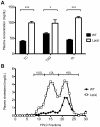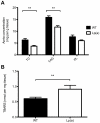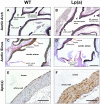Proteomic analysis of aortae from human lipoprotein(a) transgenic mice shows an early metabolic response independent of atherosclerosis
- PMID: 22276189
- PMCID: PMC3261968
- DOI: 10.1371/journal.pone.0030383
Proteomic analysis of aortae from human lipoprotein(a) transgenic mice shows an early metabolic response independent of atherosclerosis
Abstract
Background: Elevated low density lipoprotein (LDL) and lipoprotein(a) are independent risk factors for the development of atherosclerosis. Using a proteomic approach we aimed to determine early changes in arterial protein expression in transgenic mice containing both human LDL and lipoprotein(a) in circulation.
Methods and results: Plasma lipid analyses showed the lipoprotein(a) transgenic mice had significantly higher lipid levels than wildtype, including a much increased LDL and high density lipoprotein (HDL) cholesterol. Analysis of aortae from lipoprotein(a) mice showed lipoprotein(a) accumulation but no lipid accumulation or foam cells, leaving the arteries essentially atherosclerosis free. Using two-dimensional gel electrophoresis and mass spectrometry, we identified 34 arterial proteins with significantly altered abundance (P<0.05) in lipoprotein(a) transgenic mice compared to wildtype including 17 that showed a ≥2 fold difference. Some proteins of interest showed a similarly altered abundance at the transcript level. These changes collectively indicated an initial metabolic response that included a down regulation in energy, redox and lipid metabolism proteins and changes in structural proteins at a stage when atherosclerosis had not yet developed.
Conclusions: Our study shows that human LDL and lipoprotein(a) promote changes in the expression of a unique set of arterial proteins which may be early indicators of the metabolic disturbances preceding atherosclerosis.
Conflict of interest statement
Figures






Similar articles
-
Proteomic Analysis of Liver from Human Lipoprotein(a) Transgenic Mice Shows an Oxidative Stress and Lipid Export Response.Biomed Res Int. 2018 Nov 25;2018:4963942. doi: 10.1155/2018/4963942. eCollection 2018. Biomed Res Int. 2018. PMID: 30596094 Free PMC article.
-
Retention of low-density lipoprotein in atherosclerotic lesions of the mouse: evidence for a role of lipoprotein lipase.Circ Res. 2007 Oct 12;101(8):777-83. doi: 10.1161/CIRCRESAHA.107.149666. Epub 2007 Aug 30. Circ Res. 2007. PMID: 17761930
-
Dysfunctional HDL containing L159R ApoA-I leads to exacerbation of atherosclerosis in hyperlipidemic mice.Biochim Biophys Acta. 2012 Mar;1821(3):502-12. doi: 10.1016/j.bbalip.2011.08.019. Epub 2011 Sep 14. Biochim Biophys Acta. 2012. PMID: 21944998 Free PMC article.
-
[Atherogenic modification of low-density lipoproteins].Biomed Khim. 2016 May;62(4):391-402. doi: 10.18097/PBMC20166204391. Biomed Khim. 2016. PMID: 27562992 Review. Russian.
-
Circulating low density lipoprotein (LDL).Horm Mol Biol Clin Investig. 2018 Jul 31;35(2):/j/hmbci.2018.35.issue-2/hmbci-2018-0024/hmbci-2018-0024.xml. doi: 10.1515/hmbci-2018-0024. Horm Mol Biol Clin Investig. 2018. PMID: 30059347 Review.
Cited by
-
Proteomic Analysis of Liver from Human Lipoprotein(a) Transgenic Mice Shows an Oxidative Stress and Lipid Export Response.Biomed Res Int. 2018 Nov 25;2018:4963942. doi: 10.1155/2018/4963942. eCollection 2018. Biomed Res Int. 2018. PMID: 30596094 Free PMC article.
-
Searching for Atherosclerosis Biomarkers by Proteomics: A Focus on Lesion Pathogenesis and Vulnerability.Int J Mol Sci. 2023 Oct 14;24(20):15175. doi: 10.3390/ijms242015175. Int J Mol Sci. 2023. PMID: 37894856 Free PMC article. Review.
-
Screening for and management of elevated Lp(a).Curr Cardiol Rep. 2013 Nov;15(11):417. doi: 10.1007/s11886-013-0417-8. Curr Cardiol Rep. 2013. PMID: 24057771 Review.
-
Lipoprotein (a) upregulates ABCA1 in liver cells via scavenger receptor-B1 through its oxidized phospholipids.J Lipid Res. 2015 Jul;56(7):1318-28. doi: 10.1194/jlr.M056150. Epub 2015 Apr 6. J Lipid Res. 2015. PMID: 25852127 Free PMC article.
-
Glycoproteins identified from heart failure and treatment models.Proteomics. 2015 Jan;15(2-3):567-79. doi: 10.1002/pmic.201400151. Epub 2014 Oct 9. Proteomics. 2015. PMID: 25141849 Free PMC article.
References
-
- Plump AS, Smith JD, Hayek T, Aalto-Setala K, Walsh A, et al. Severe hypercholesterolemia and atherosclerosis in apolipoprotein E-deficient mice created by homologous recombination in ES cells. Cell. 1992;71:343–353. - PubMed
-
- Zhang SH, Reddick RL, Piedrahita JA, Maeda N. Spontaneous hypercholesterolemia and arterial lesions in mice lacking apolipoprotein E. Science. 1992;258:468–471. - PubMed
-
- Meir KS, Leitersdorf E. Atherosclerosis in the apolipoprotein-E-deficient mouse: a decade of progress. Arterioscler Thromb Vasc Biol. 2004;24:1006–1014. - PubMed
Publication types
MeSH terms
Substances
LinkOut - more resources
Full Text Sources
Other Literature Sources
Medical

